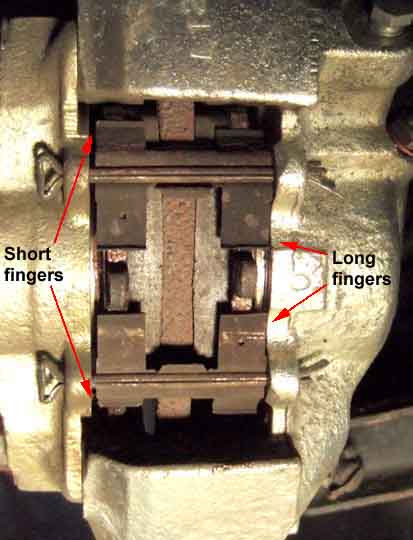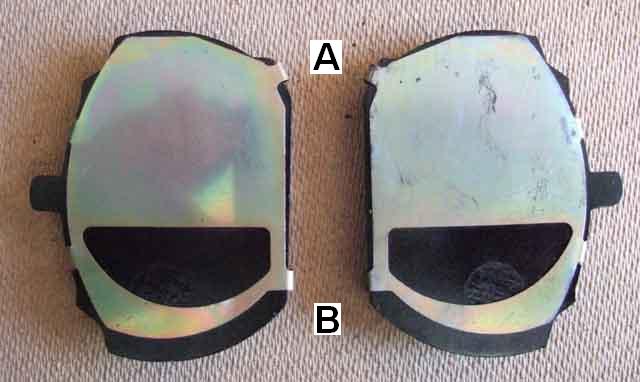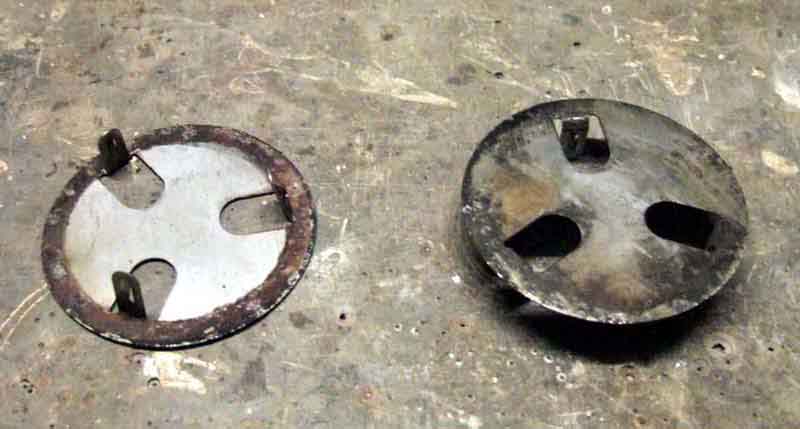The pad retaining springs, showing the two longer fingers on each retainer facing each other. These also have a pin-hole in the longer fingers.

V8 pads are handed - there is an inner and an outer for each caliper, the 'handing' can be seen as a sticking-out bit on one inner corner of each pad, circled. Below shows a pair for one caliper on the left and another pair on the right. Both pairs are the same, which may seem to be incorrect, as the pad that goes in the outside half of the caliper one side of the car goes in the inside half of the other! That puts the circled sticking-out bit on each pad in the same position in each half of each caliper.

With the pads fitted you can see the sticking-out bit uppermost (A), and the curved corner at the bottom (B). You can also see how a protrusion on the lower caliper bridge (C) is what prevents the pads being fitted the other way round:

Note also that the shims are handed - the tabs at A and B are at different angles. This means that they only go on one pad each side, as well as each pad only going in one side of the caliper. After 20 years I only recently wondered how the cut-outs in these shims were orientated relative to the cut-out in the caliper piston, which has to face the spindle. I soon realised that with both shim and pad being handed there is no room for error, but it does mean the cut-out in the piston is at right-angles to the cut-out in the shim, resulting in a rather complex force of the piston on the pad, and - from back pressure of the pad on the disc - of the piston in its bore.


Comparison of 4-cylinder (left) to V8 (right). Rubberised coating on the back of the 4-cylinder with no shim. And despite shims being included with the above set none with this set, even though they did come with retaining springs and split-pins, which isn't always the case.

V8 pads in 4-cylinder calipers: With the 'tops' aligned the 'bottoms' of the V8 pads extend a bit further:

There is noticeably more friction material closer to the stub-axle:

V8 pad on 4-cylinder disc: On the outer face of the disc some of that extra material is not doing anything and as the pads wear that unused part will lodge in the recess in the disc meaning the piston will have to be retracted more than usual to remove them:

Whereas on the inner face all the friction surface is used. Some dismantling will be required to clean up that additional area on the disc when fitting V8 pads to 4-cylinder calipers for the first time - or new or skimmed discs, but it will result in imbalance between the two faces of the disc, which may have unwanted effects including warping:

Confirmed in the caliper - 4-cylinder pad with 4-cylinder caliper and disc:

V8 pad with 4-cylinder caliper and disc:

V8 pad with V8 caliper and disc. Both discs are 273mm diameter, but note the narrower 'channel' between the inner edge of the pad surface and the hub, which gives the wider pad area. V8 discs are thicker and won't fit the 4-cylinder calipers with new pads:

In the above pictures of the V8 pads the apparent gap between friction material and disc is due to the chamfering on these new pads, thought to be in response to squeal:

MG ZS shims with prongs that project into the pistons, similar to Peugeot shims which some have said have cured their MGB squeal. Only one per side on the ZS, whereas I need two for each MGB, or three more ZS pad changes ...

